Legal Analysis: Copyright Infringement and Libel Case Study
VerifiedAdded on 2023/06/05
|7
|2396
|280
Case Study
AI Summary
This case study provides legal advice to a composer and singer, Lei Lan, facing potential copyright infringement claims and a libel action. The analysis covers the use of copyrighted lyrics without permission, homemade recordings, and defamatory statements posted on Facebook. It examines relevant Australian laws, including the Copyright Act 1968 and the Defamation Act 2005, and case law to assess the likelihood of copyright infringement and the viability of a libel claim. The advice recommends pursuing out-of-court settlement for copyright issues and abandoning the libel action, considering potential defenses and costs. The document concludes with recommendations and next steps for legal consultation. Desklib provides access to this and many other solved assignments for students.
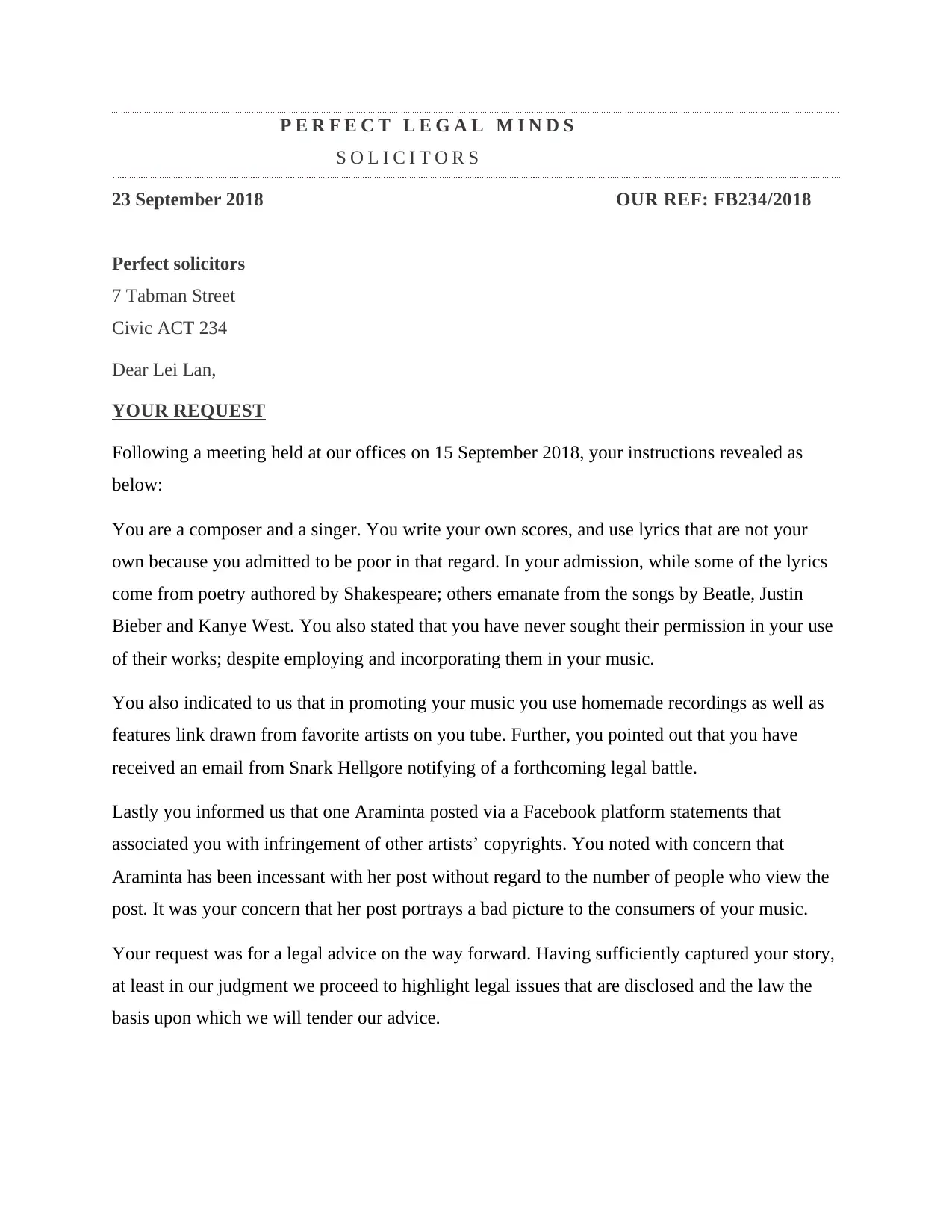
P E R F E C T L E G A L M I N D S
S O L I C I T O R S
23 September 2018 OUR REF: FB234/2018
Perfect solicitors
7 Tabman Street
Civic ACT 234
Dear Lei Lan,
YOUR REQUEST
Following a meeting held at our offices on 15 September 2018, your instructions revealed as
below:
You are a composer and a singer. You write your own scores, and use lyrics that are not your
own because you admitted to be poor in that regard. In your admission, while some of the lyrics
come from poetry authored by Shakespeare; others emanate from the songs by Beatle, Justin
Bieber and Kanye West. You also stated that you have never sought their permission in your use
of their works; despite employing and incorporating them in your music.
You also indicated to us that in promoting your music you use homemade recordings as well as
features link drawn from favorite artists on you tube. Further, you pointed out that you have
received an email from Snark Hellgore notifying of a forthcoming legal battle.
Lastly you informed us that one Araminta posted via a Facebook platform statements that
associated you with infringement of other artists’ copyrights. You noted with concern that
Araminta has been incessant with her post without regard to the number of people who view the
post. It was your concern that her post portrays a bad picture to the consumers of your music.
Your request was for a legal advice on the way forward. Having sufficiently captured your story,
at least in our judgment we proceed to highlight legal issues that are disclosed and the law the
basis upon which we will tender our advice.
S O L I C I T O R S
23 September 2018 OUR REF: FB234/2018
Perfect solicitors
7 Tabman Street
Civic ACT 234
Dear Lei Lan,
YOUR REQUEST
Following a meeting held at our offices on 15 September 2018, your instructions revealed as
below:
You are a composer and a singer. You write your own scores, and use lyrics that are not your
own because you admitted to be poor in that regard. In your admission, while some of the lyrics
come from poetry authored by Shakespeare; others emanate from the songs by Beatle, Justin
Bieber and Kanye West. You also stated that you have never sought their permission in your use
of their works; despite employing and incorporating them in your music.
You also indicated to us that in promoting your music you use homemade recordings as well as
features link drawn from favorite artists on you tube. Further, you pointed out that you have
received an email from Snark Hellgore notifying of a forthcoming legal battle.
Lastly you informed us that one Araminta posted via a Facebook platform statements that
associated you with infringement of other artists’ copyrights. You noted with concern that
Araminta has been incessant with her post without regard to the number of people who view the
post. It was your concern that her post portrays a bad picture to the consumers of your music.
Your request was for a legal advice on the way forward. Having sufficiently captured your story,
at least in our judgment we proceed to highlight legal issues that are disclosed and the law the
basis upon which we will tender our advice.
Paraphrase This Document
Need a fresh take? Get an instant paraphrase of this document with our AI Paraphraser
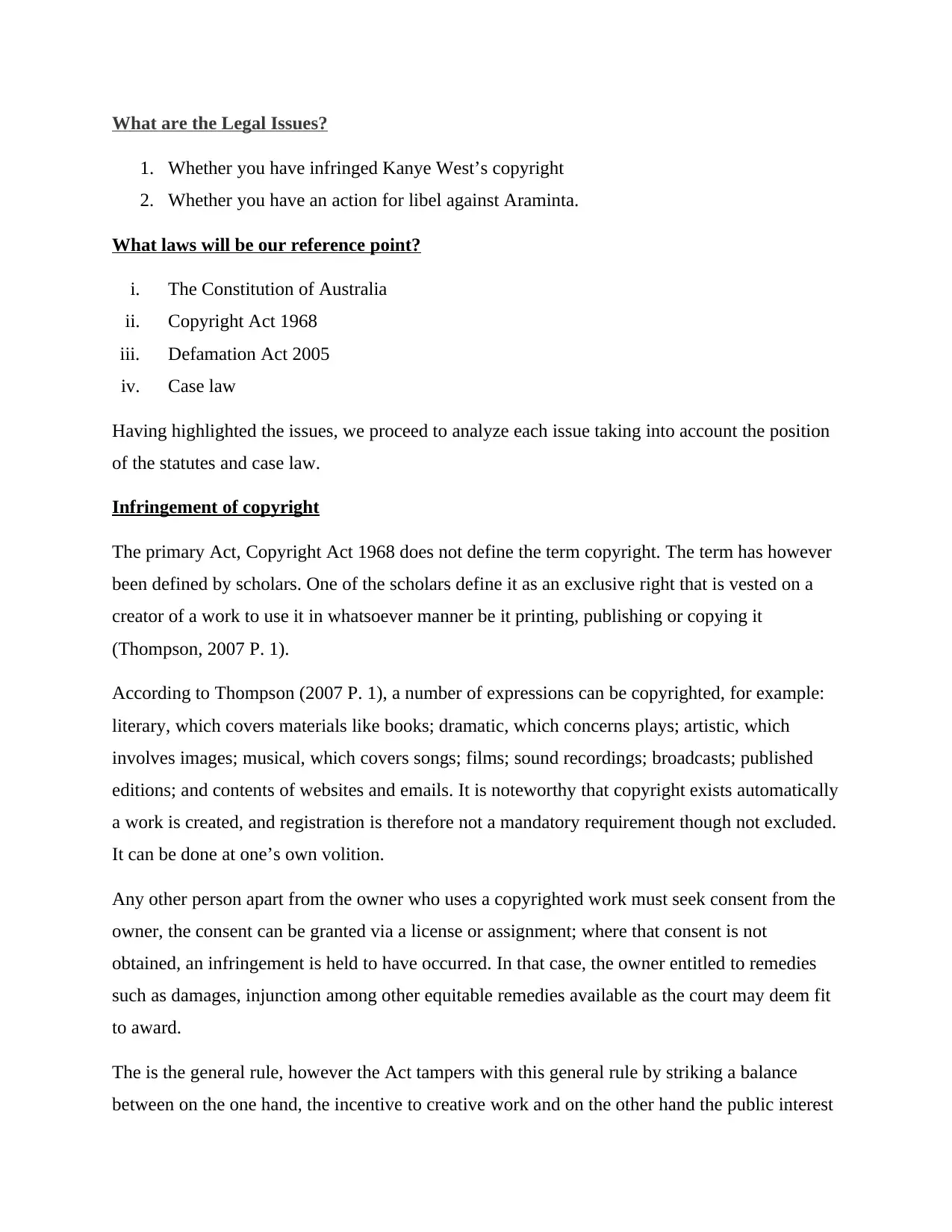
What are the Legal Issues?
1. Whether you have infringed Kanye West’s copyright
2. Whether you have an action for libel against Araminta.
What laws will be our reference point?
i. The Constitution of Australia
ii. Copyright Act 1968
iii. Defamation Act 2005
iv. Case law
Having highlighted the issues, we proceed to analyze each issue taking into account the position
of the statutes and case law.
Infringement of copyright
The primary Act, Copyright Act 1968 does not define the term copyright. The term has however
been defined by scholars. One of the scholars define it as an exclusive right that is vested on a
creator of a work to use it in whatsoever manner be it printing, publishing or copying it
(Thompson, 2007 P. 1).
According to Thompson (2007 P. 1), a number of expressions can be copyrighted, for example:
literary, which covers materials like books; dramatic, which concerns plays; artistic, which
involves images; musical, which covers songs; films; sound recordings; broadcasts; published
editions; and contents of websites and emails. It is noteworthy that copyright exists automatically
a work is created, and registration is therefore not a mandatory requirement though not excluded.
It can be done at one’s own volition.
Any other person apart from the owner who uses a copyrighted work must seek consent from the
owner, the consent can be granted via a license or assignment; where that consent is not
obtained, an infringement is held to have occurred. In that case, the owner entitled to remedies
such as damages, injunction among other equitable remedies available as the court may deem fit
to award.
The is the general rule, however the Act tampers with this general rule by striking a balance
between on the one hand, the incentive to creative work and on the other hand the public interest
1. Whether you have infringed Kanye West’s copyright
2. Whether you have an action for libel against Araminta.
What laws will be our reference point?
i. The Constitution of Australia
ii. Copyright Act 1968
iii. Defamation Act 2005
iv. Case law
Having highlighted the issues, we proceed to analyze each issue taking into account the position
of the statutes and case law.
Infringement of copyright
The primary Act, Copyright Act 1968 does not define the term copyright. The term has however
been defined by scholars. One of the scholars define it as an exclusive right that is vested on a
creator of a work to use it in whatsoever manner be it printing, publishing or copying it
(Thompson, 2007 P. 1).
According to Thompson (2007 P. 1), a number of expressions can be copyrighted, for example:
literary, which covers materials like books; dramatic, which concerns plays; artistic, which
involves images; musical, which covers songs; films; sound recordings; broadcasts; published
editions; and contents of websites and emails. It is noteworthy that copyright exists automatically
a work is created, and registration is therefore not a mandatory requirement though not excluded.
It can be done at one’s own volition.
Any other person apart from the owner who uses a copyrighted work must seek consent from the
owner, the consent can be granted via a license or assignment; where that consent is not
obtained, an infringement is held to have occurred. In that case, the owner entitled to remedies
such as damages, injunction among other equitable remedies available as the court may deem fit
to award.
The is the general rule, however the Act tampers with this general rule by striking a balance
between on the one hand, the incentive to creative work and on the other hand the public interest
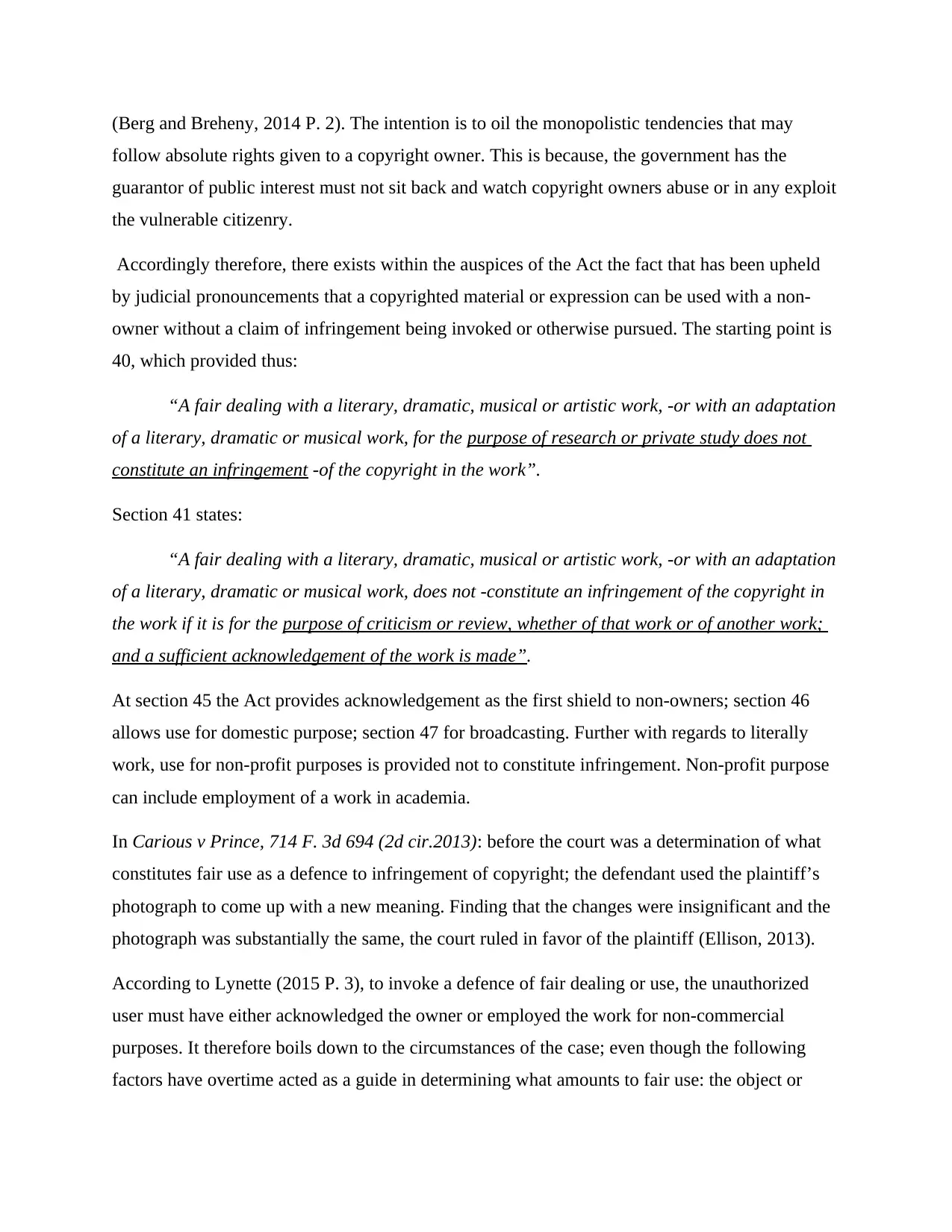
(Berg and Breheny, 2014 P. 2). The intention is to oil the monopolistic tendencies that may
follow absolute rights given to a copyright owner. This is because, the government has the
guarantor of public interest must not sit back and watch copyright owners abuse or in any exploit
the vulnerable citizenry.
Accordingly therefore, there exists within the auspices of the Act the fact that has been upheld
by judicial pronouncements that a copyrighted material or expression can be used with a non-
owner without a claim of infringement being invoked or otherwise pursued. The starting point is
40, which provided thus:
“A fair dealing with a literary, dramatic, musical or artistic work, -or with an adaptation
of a literary, dramatic or musical work, for the purpose of research or private study does not
constitute an infringement -of the copyright in the work”.
Section 41 states:
“A fair dealing with a literary, dramatic, musical or artistic work, -or with an adaptation
of a literary, dramatic or musical work, does not -constitute an infringement of the copyright in
the work if it is for the purpose of criticism or review, whether of that work or of another work;
and a sufficient acknowledgement of the work is made”.
At section 45 the Act provides acknowledgement as the first shield to non-owners; section 46
allows use for domestic purpose; section 47 for broadcasting. Further with regards to literally
work, use for non-profit purposes is provided not to constitute infringement. Non-profit purpose
can include employment of a work in academia.
In Carious v Prince, 714 F. 3d 694 (2d cir.2013): before the court was a determination of what
constitutes fair use as a defence to infringement of copyright; the defendant used the plaintiff’s
photograph to come up with a new meaning. Finding that the changes were insignificant and the
photograph was substantially the same, the court ruled in favor of the plaintiff (Ellison, 2013).
According to Lynette (2015 P. 3), to invoke a defence of fair dealing or use, the unauthorized
user must have either acknowledged the owner or employed the work for non-commercial
purposes. It therefore boils down to the circumstances of the case; even though the following
factors have overtime acted as a guide in determining what amounts to fair use: the object or
follow absolute rights given to a copyright owner. This is because, the government has the
guarantor of public interest must not sit back and watch copyright owners abuse or in any exploit
the vulnerable citizenry.
Accordingly therefore, there exists within the auspices of the Act the fact that has been upheld
by judicial pronouncements that a copyrighted material or expression can be used with a non-
owner without a claim of infringement being invoked or otherwise pursued. The starting point is
40, which provided thus:
“A fair dealing with a literary, dramatic, musical or artistic work, -or with an adaptation
of a literary, dramatic or musical work, for the purpose of research or private study does not
constitute an infringement -of the copyright in the work”.
Section 41 states:
“A fair dealing with a literary, dramatic, musical or artistic work, -or with an adaptation
of a literary, dramatic or musical work, does not -constitute an infringement of the copyright in
the work if it is for the purpose of criticism or review, whether of that work or of another work;
and a sufficient acknowledgement of the work is made”.
At section 45 the Act provides acknowledgement as the first shield to non-owners; section 46
allows use for domestic purpose; section 47 for broadcasting. Further with regards to literally
work, use for non-profit purposes is provided not to constitute infringement. Non-profit purpose
can include employment of a work in academia.
In Carious v Prince, 714 F. 3d 694 (2d cir.2013): before the court was a determination of what
constitutes fair use as a defence to infringement of copyright; the defendant used the plaintiff’s
photograph to come up with a new meaning. Finding that the changes were insignificant and the
photograph was substantially the same, the court ruled in favor of the plaintiff (Ellison, 2013).
According to Lynette (2015 P. 3), to invoke a defence of fair dealing or use, the unauthorized
user must have either acknowledged the owner or employed the work for non-commercial
purposes. It therefore boils down to the circumstances of the case; even though the following
factors have overtime acted as a guide in determining what amounts to fair use: the object or
⊘ This is a preview!⊘
Do you want full access?
Subscribe today to unlock all pages.

Trusted by 1+ million students worldwide
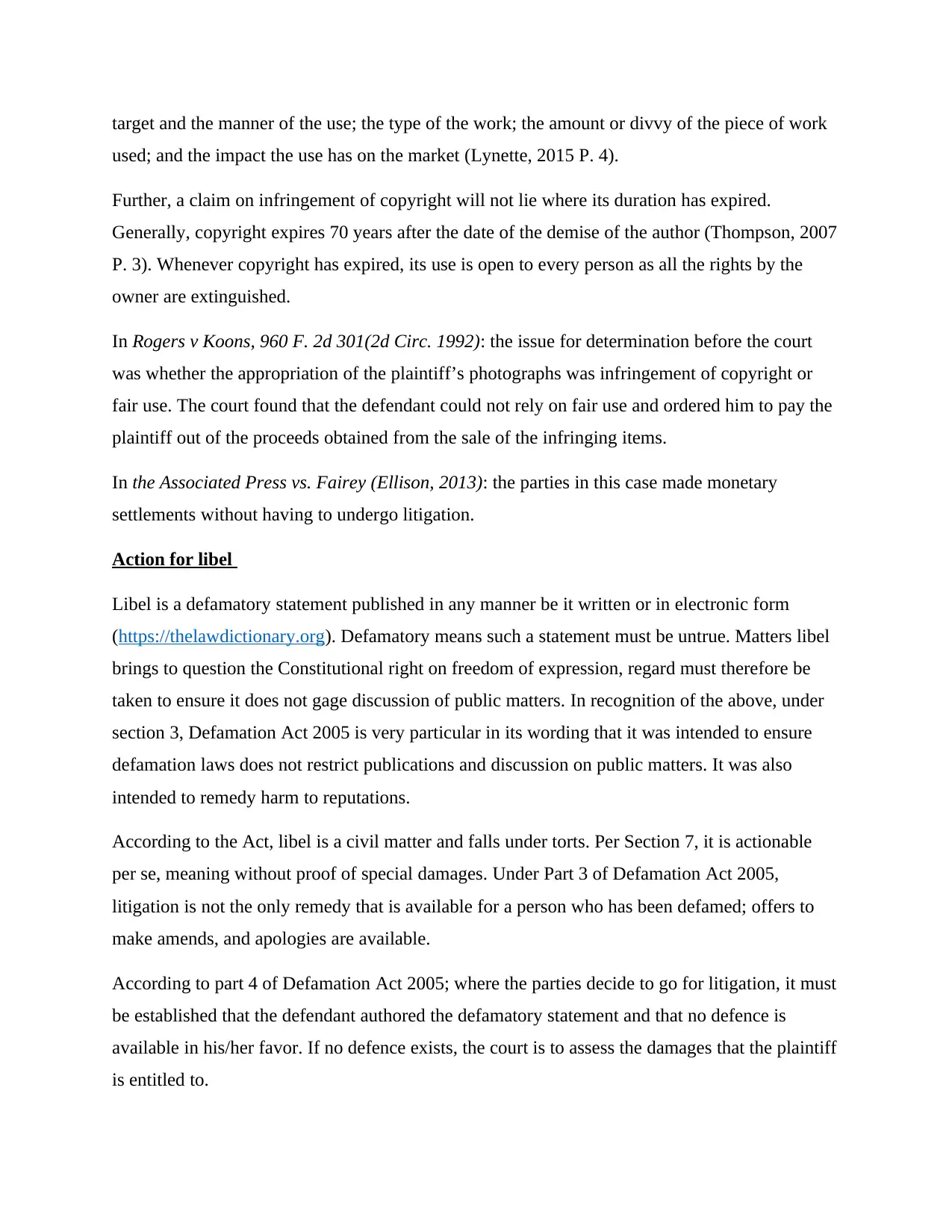
target and the manner of the use; the type of the work; the amount or divvy of the piece of work
used; and the impact the use has on the market (Lynette, 2015 P. 4).
Further, a claim on infringement of copyright will not lie where its duration has expired.
Generally, copyright expires 70 years after the date of the demise of the author (Thompson, 2007
P. 3). Whenever copyright has expired, its use is open to every person as all the rights by the
owner are extinguished.
In Rogers v Koons, 960 F. 2d 301(2d Circ. 1992): the issue for determination before the court
was whether the appropriation of the plaintiff’s photographs was infringement of copyright or
fair use. The court found that the defendant could not rely on fair use and ordered him to pay the
plaintiff out of the proceeds obtained from the sale of the infringing items.
In the Associated Press vs. Fairey (Ellison, 2013): the parties in this case made monetary
settlements without having to undergo litigation.
Action for libel
Libel is a defamatory statement published in any manner be it written or in electronic form
(https://thelawdictionary.org). Defamatory means such a statement must be untrue. Matters libel
brings to question the Constitutional right on freedom of expression, regard must therefore be
taken to ensure it does not gage discussion of public matters. In recognition of the above, under
section 3, Defamation Act 2005 is very particular in its wording that it was intended to ensure
defamation laws does not restrict publications and discussion on public matters. It was also
intended to remedy harm to reputations.
According to the Act, libel is a civil matter and falls under torts. Per Section 7, it is actionable
per se, meaning without proof of special damages. Under Part 3 of Defamation Act 2005,
litigation is not the only remedy that is available for a person who has been defamed; offers to
make amends, and apologies are available.
According to part 4 of Defamation Act 2005; where the parties decide to go for litigation, it must
be established that the defendant authored the defamatory statement and that no defence is
available in his/her favor. If no defence exists, the court is to assess the damages that the plaintiff
is entitled to.
used; and the impact the use has on the market (Lynette, 2015 P. 4).
Further, a claim on infringement of copyright will not lie where its duration has expired.
Generally, copyright expires 70 years after the date of the demise of the author (Thompson, 2007
P. 3). Whenever copyright has expired, its use is open to every person as all the rights by the
owner are extinguished.
In Rogers v Koons, 960 F. 2d 301(2d Circ. 1992): the issue for determination before the court
was whether the appropriation of the plaintiff’s photographs was infringement of copyright or
fair use. The court found that the defendant could not rely on fair use and ordered him to pay the
plaintiff out of the proceeds obtained from the sale of the infringing items.
In the Associated Press vs. Fairey (Ellison, 2013): the parties in this case made monetary
settlements without having to undergo litigation.
Action for libel
Libel is a defamatory statement published in any manner be it written or in electronic form
(https://thelawdictionary.org). Defamatory means such a statement must be untrue. Matters libel
brings to question the Constitutional right on freedom of expression, regard must therefore be
taken to ensure it does not gage discussion of public matters. In recognition of the above, under
section 3, Defamation Act 2005 is very particular in its wording that it was intended to ensure
defamation laws does not restrict publications and discussion on public matters. It was also
intended to remedy harm to reputations.
According to the Act, libel is a civil matter and falls under torts. Per Section 7, it is actionable
per se, meaning without proof of special damages. Under Part 3 of Defamation Act 2005,
litigation is not the only remedy that is available for a person who has been defamed; offers to
make amends, and apologies are available.
According to part 4 of Defamation Act 2005; where the parties decide to go for litigation, it must
be established that the defendant authored the defamatory statement and that no defence is
available in his/her favor. If no defence exists, the court is to assess the damages that the plaintiff
is entitled to.
Paraphrase This Document
Need a fresh take? Get an instant paraphrase of this document with our AI Paraphraser
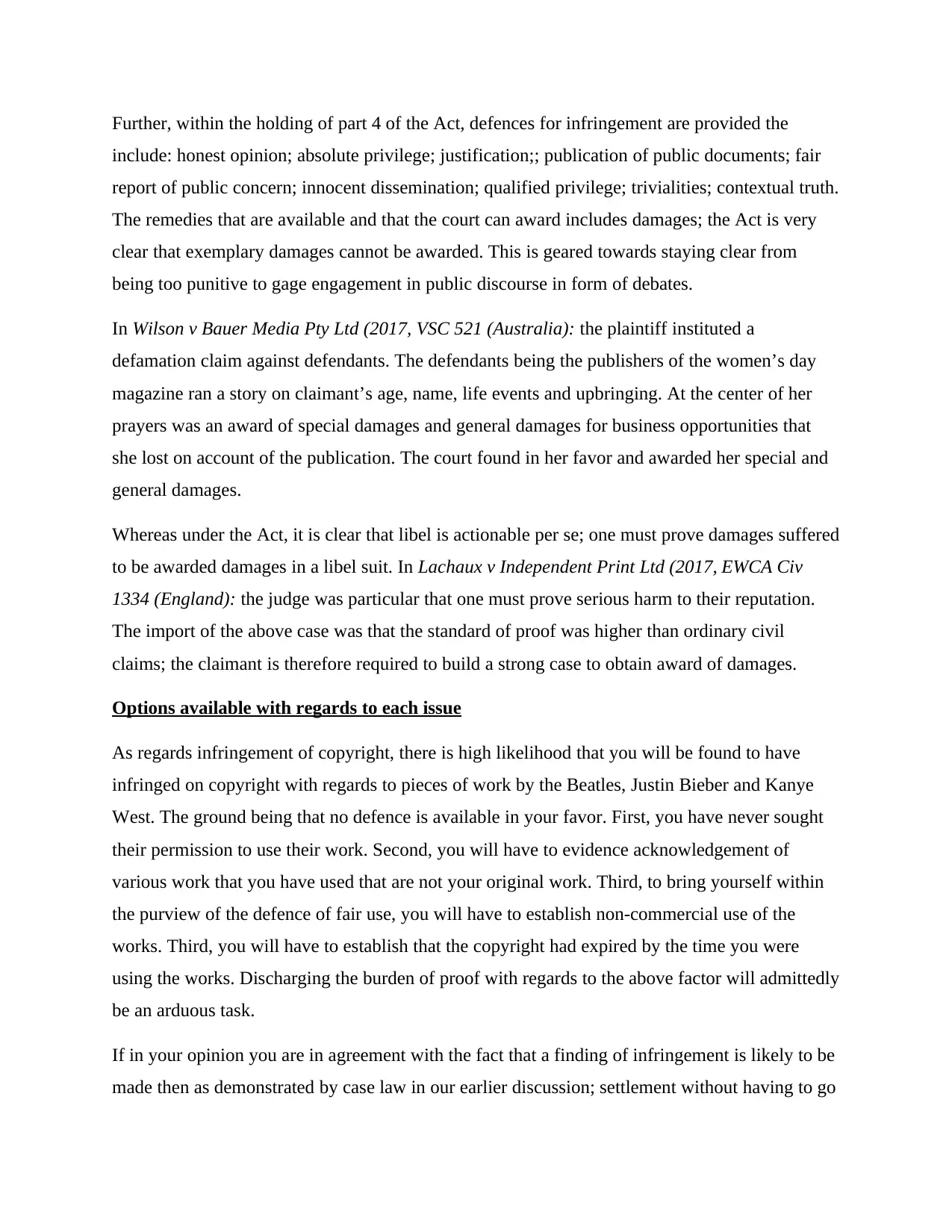
Further, within the holding of part 4 of the Act, defences for infringement are provided the
include: honest opinion; absolute privilege; justification;; publication of public documents; fair
report of public concern; innocent dissemination; qualified privilege; trivialities; contextual truth.
The remedies that are available and that the court can award includes damages; the Act is very
clear that exemplary damages cannot be awarded. This is geared towards staying clear from
being too punitive to gage engagement in public discourse in form of debates.
In Wilson v Bauer Media Pty Ltd (2017, VSC 521 (Australia): the plaintiff instituted a
defamation claim against defendants. The defendants being the publishers of the women’s day
magazine ran a story on claimant’s age, name, life events and upbringing. At the center of her
prayers was an award of special damages and general damages for business opportunities that
she lost on account of the publication. The court found in her favor and awarded her special and
general damages.
Whereas under the Act, it is clear that libel is actionable per se; one must prove damages suffered
to be awarded damages in a libel suit. In Lachaux v Independent Print Ltd (2017, EWCA Civ
1334 (England): the judge was particular that one must prove serious harm to their reputation.
The import of the above case was that the standard of proof was higher than ordinary civil
claims; the claimant is therefore required to build a strong case to obtain award of damages.
Options available with regards to each issue
As regards infringement of copyright, there is high likelihood that you will be found to have
infringed on copyright with regards to pieces of work by the Beatles, Justin Bieber and Kanye
West. The ground being that no defence is available in your favor. First, you have never sought
their permission to use their work. Second, you will have to evidence acknowledgement of
various work that you have used that are not your original work. Third, to bring yourself within
the purview of the defence of fair use, you will have to establish non-commercial use of the
works. Third, you will have to establish that the copyright had expired by the time you were
using the works. Discharging the burden of proof with regards to the above factor will admittedly
be an arduous task.
If in your opinion you are in agreement with the fact that a finding of infringement is likely to be
made then as demonstrated by case law in our earlier discussion; settlement without having to go
include: honest opinion; absolute privilege; justification;; publication of public documents; fair
report of public concern; innocent dissemination; qualified privilege; trivialities; contextual truth.
The remedies that are available and that the court can award includes damages; the Act is very
clear that exemplary damages cannot be awarded. This is geared towards staying clear from
being too punitive to gage engagement in public discourse in form of debates.
In Wilson v Bauer Media Pty Ltd (2017, VSC 521 (Australia): the plaintiff instituted a
defamation claim against defendants. The defendants being the publishers of the women’s day
magazine ran a story on claimant’s age, name, life events and upbringing. At the center of her
prayers was an award of special damages and general damages for business opportunities that
she lost on account of the publication. The court found in her favor and awarded her special and
general damages.
Whereas under the Act, it is clear that libel is actionable per se; one must prove damages suffered
to be awarded damages in a libel suit. In Lachaux v Independent Print Ltd (2017, EWCA Civ
1334 (England): the judge was particular that one must prove serious harm to their reputation.
The import of the above case was that the standard of proof was higher than ordinary civil
claims; the claimant is therefore required to build a strong case to obtain award of damages.
Options available with regards to each issue
As regards infringement of copyright, there is high likelihood that you will be found to have
infringed on copyright with regards to pieces of work by the Beatles, Justin Bieber and Kanye
West. The ground being that no defence is available in your favor. First, you have never sought
their permission to use their work. Second, you will have to evidence acknowledgement of
various work that you have used that are not your original work. Third, to bring yourself within
the purview of the defence of fair use, you will have to establish non-commercial use of the
works. Third, you will have to establish that the copyright had expired by the time you were
using the works. Discharging the burden of proof with regards to the above factor will admittedly
be an arduous task.
If in your opinion you are in agreement with the fact that a finding of infringement is likely to be
made then as demonstrated by case law in our earlier discussion; settlement without having to go
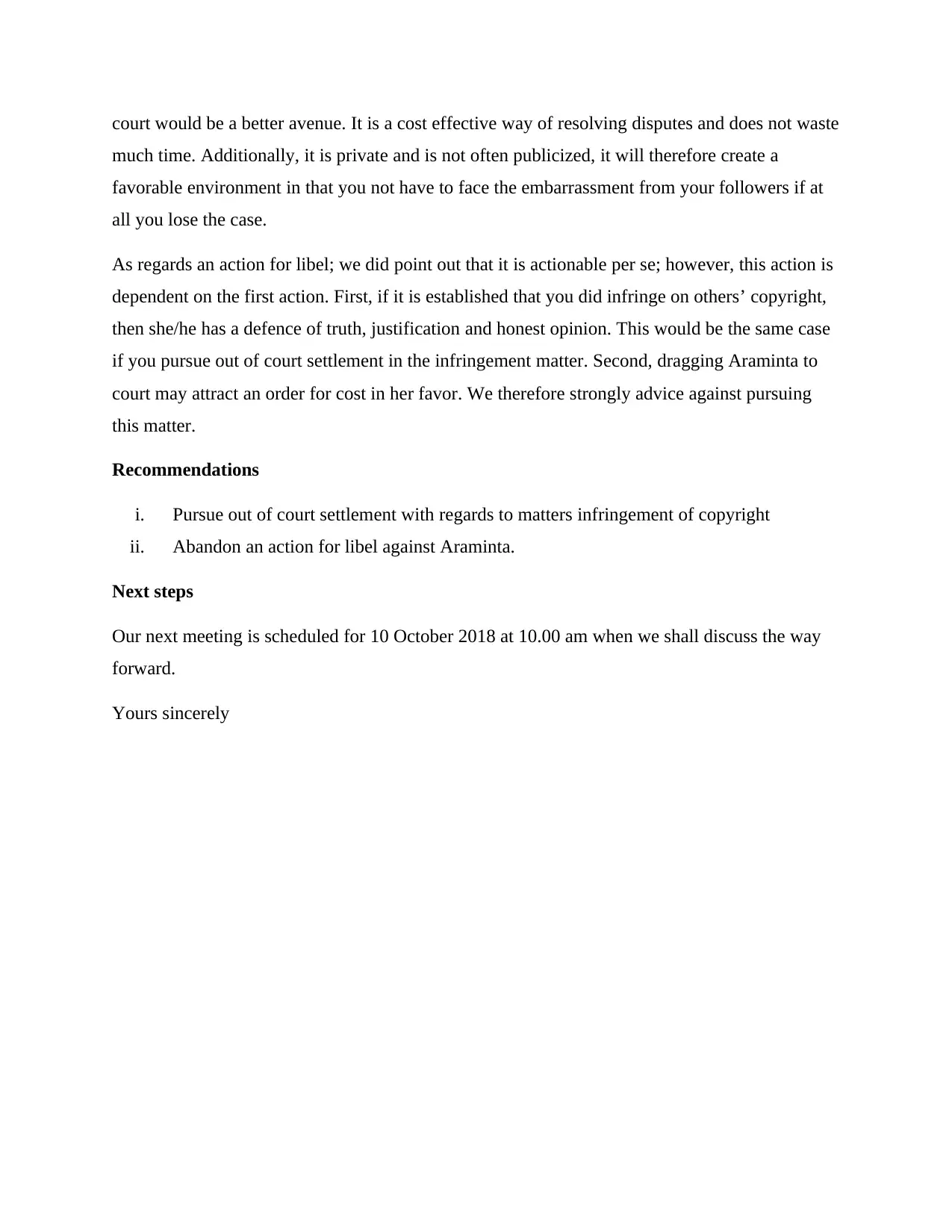
court would be a better avenue. It is a cost effective way of resolving disputes and does not waste
much time. Additionally, it is private and is not often publicized, it will therefore create a
favorable environment in that you not have to face the embarrassment from your followers if at
all you lose the case.
As regards an action for libel; we did point out that it is actionable per se; however, this action is
dependent on the first action. First, if it is established that you did infringe on others’ copyright,
then she/he has a defence of truth, justification and honest opinion. This would be the same case
if you pursue out of court settlement in the infringement matter. Second, dragging Araminta to
court may attract an order for cost in her favor. We therefore strongly advice against pursuing
this matter.
Recommendations
i. Pursue out of court settlement with regards to matters infringement of copyright
ii. Abandon an action for libel against Araminta.
Next steps
Our next meeting is scheduled for 10 October 2018 at 10.00 am when we shall discuss the way
forward.
Yours sincerely
much time. Additionally, it is private and is not often publicized, it will therefore create a
favorable environment in that you not have to face the embarrassment from your followers if at
all you lose the case.
As regards an action for libel; we did point out that it is actionable per se; however, this action is
dependent on the first action. First, if it is established that you did infringe on others’ copyright,
then she/he has a defence of truth, justification and honest opinion. This would be the same case
if you pursue out of court settlement in the infringement matter. Second, dragging Araminta to
court may attract an order for cost in her favor. We therefore strongly advice against pursuing
this matter.
Recommendations
i. Pursue out of court settlement with regards to matters infringement of copyright
ii. Abandon an action for libel against Araminta.
Next steps
Our next meeting is scheduled for 10 October 2018 at 10.00 am when we shall discuss the way
forward.
Yours sincerely
⊘ This is a preview!⊘
Do you want full access?
Subscribe today to unlock all pages.

Trusted by 1+ million students worldwide

Bibliography
Laws
The constitution
Copyright Act 1968
Defamation Act 2005
Cases
Rogers v Koons, 960 F. 2d 301(2d Circ. 1992)
Carious v Prince, 714 F. 3d 694 (2d cir.2013):
Wilson v Bauer Media Pty Ltd (2017, VSC 521 (Australia)
Lachaux v Independent Print Ltd (2017, EWCA Civ 1334 (England)
The Associated Press vs. Fairey (Ellison, 2013)
Articles
Berg C. and Breheny S., (2014) Submission to Australian government Online Copyright
infringement Discussion paper. Institute of the voice of freedom established− 1 9 4 3.
Thompson H., (2007) introduction to copyright. University Copyright Office, University of
Melbourne.
Ellison K. (2013) 5 famous copyright infringement cases (and what you can learn). Available
from: https://99designs.com/blog/tips/5-famous-copyright-infringement-cases/ 23 September
2018
Lynette O., (2015) Fair dealing: a concept in UK Copyright law. Journal of Scholarly Publishing,
University of Toronto Press 3, 28.
Others
< https://thelawdictionary.org>
Laws
The constitution
Copyright Act 1968
Defamation Act 2005
Cases
Rogers v Koons, 960 F. 2d 301(2d Circ. 1992)
Carious v Prince, 714 F. 3d 694 (2d cir.2013):
Wilson v Bauer Media Pty Ltd (2017, VSC 521 (Australia)
Lachaux v Independent Print Ltd (2017, EWCA Civ 1334 (England)
The Associated Press vs. Fairey (Ellison, 2013)
Articles
Berg C. and Breheny S., (2014) Submission to Australian government Online Copyright
infringement Discussion paper. Institute of the voice of freedom established− 1 9 4 3.
Thompson H., (2007) introduction to copyright. University Copyright Office, University of
Melbourne.
Ellison K. (2013) 5 famous copyright infringement cases (and what you can learn). Available
from: https://99designs.com/blog/tips/5-famous-copyright-infringement-cases/ 23 September
2018
Lynette O., (2015) Fair dealing: a concept in UK Copyright law. Journal of Scholarly Publishing,
University of Toronto Press 3, 28.
Others
< https://thelawdictionary.org>
1 out of 7
Your All-in-One AI-Powered Toolkit for Academic Success.
+13062052269
info@desklib.com
Available 24*7 on WhatsApp / Email
![[object Object]](/_next/static/media/star-bottom.7253800d.svg)
Unlock your academic potential
Copyright © 2020–2025 A2Z Services. All Rights Reserved. Developed and managed by ZUCOL.
